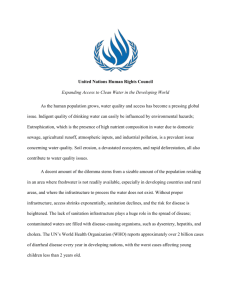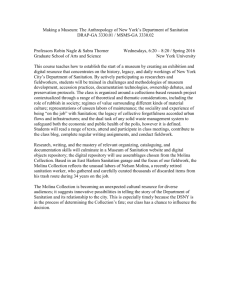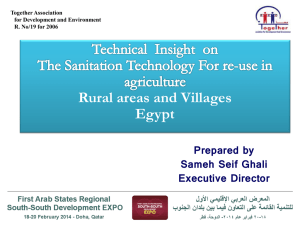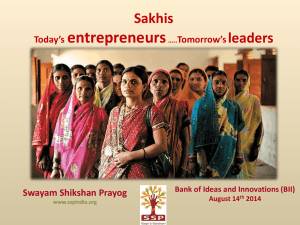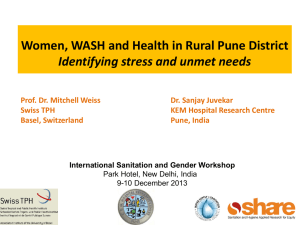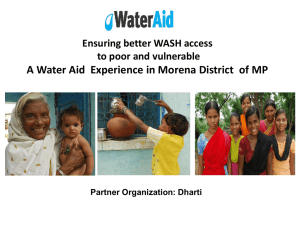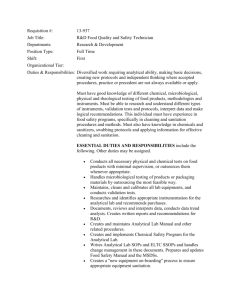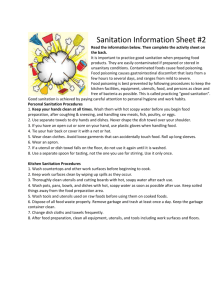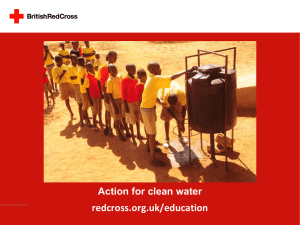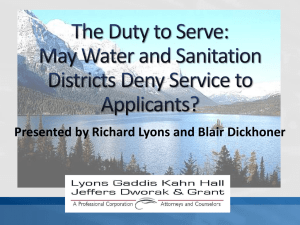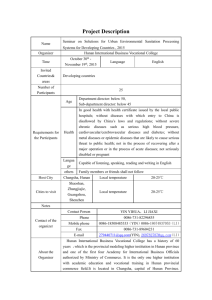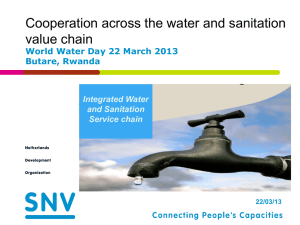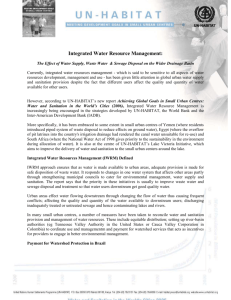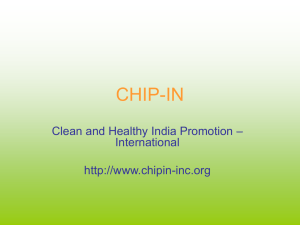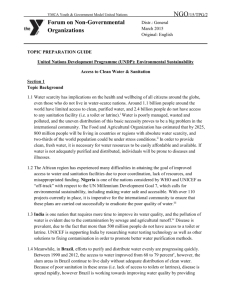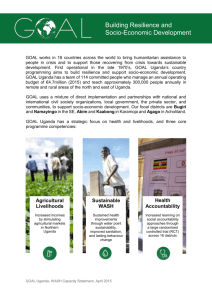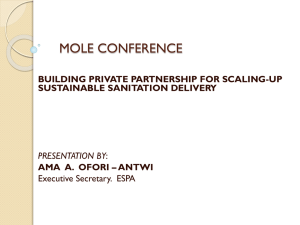Powerpoint slideshow
advertisement
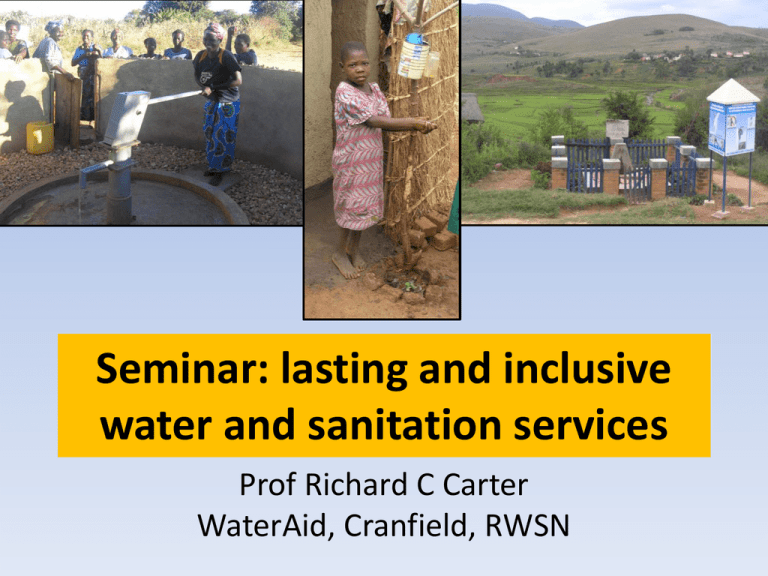
Seminar: lasting and inclusive water and sanitation services Prof Richard C Carter WaterAid, Cranfield, RWSN Water, sanitation and hygiene (WASH) in low-income countries and communities • • • • • • Outlining the problem Why do anything? Who should be served, who do the serving? To achieve what? How to deliver sustainable inclusive services? When will this be achieved? Joint Monitoring Programme (JMP) 884m people still do not enjoy an improved water supply. More than a third of the unserved live in sub-Saharan Africa. Five out of six of the global unserved live in rural areas. Drinking water Joint Monitoring Programme (JMP) 2.6bn people still do not enjoy improved sanitation. 72% of the unserved are in S. Asia, and sub-Saharan Africa is poorly served. Seven out of ten of the unserved live in rural areas. Sanitation What does ‘improved’ mean? Disparities in access to improved services Drinking water Sanitation So why should we do anything? (1) Adequate water supply and sanitation are human rights. What does this mean? ‘Access to safe water is a fundamental human need and therefore a basic human right’. [Kofi Annan] [Right to water information portal http://www.righttowater.info/ ] ‘Human rights are the inherent rights every individual has, just for being human. They are therefore independent from any state rule. Human rights reflect a global moral conscience, with roots in philosophies, religions and cultures throughout the world.’ So why should we do anything? (2) Access to services is a matter of justice and equity – ‘what is it that your God requires …?’ Are there dangers in polarising people into ‘rights-holders’ and ‘duty-bearers’? How do rights relate to responsibilities? Is there a difference between something being ‘a right’ and being right and fair? What do the faiths of the world say? So why should we do anything? (3) Water and sanitation services are public goods, not merely private goods. In the case of hygiene and sanitation especially, your behaviour can have a serious impact on my health. Should the improvement and maintenance of good sanitation and water supplies be mandatory, not merely a matter of individual choice? So why should we do anything? (4) Good business – a win-win situation in which providers make a living and consumers are served. What do you think? From why to who … • Should WASH programmes target the poor(est)? • Should we serve those who can pay? • Should we aim to serve all? A proposition: to serve all • Remove the structural barriers which exclude the poorest – institutional ignorance, the invisibility of the rural poor, the myth (at least in urban contexts) that the poor can’t pay, the poverty of those who really cannot. • Find ways to cross-subsidise the poorest (and most poorly served) with revenues from wealthier, better-served households. Who should provide WASH services? • National Governments Mandate, decentralisation, delegation, scale • Donors and lenders Domination of ideas and investment, fickleness • The private sector Normative provider of goods and services. Investor? • NGOs & faith-based agencies Scale, independence, groundedness What are we trying to achieve? • Better health. • Time saving leading to increased incomes. • Better school attendance. • A cleaner environment. • ‘Green’ solutions – re-use / recycling of waste. • Others …… ? What do water and sanitation users want? • Services which are • For water supply: ready reliable and affordable access enabling and which impose only sufficient quantity of a limited management water to be taken, of burden on users. acceptable quality. • For sanitation: the safety, privacy, comfort and dignity of an accessible toilet (plus status, utility). Perspectives of professionals and of service users [Gates Foundation WASH Landscaping Study http://www.irc.nl/page/35950 ] What users want to have and what sector professionals want to give: Goals of sector professionals: MDGs, coverage If the objectives of all the stakeholders are not focused on a common goal – a goal especially shared and articulated by the users of water and sanitation services – then efforts will be diluted. • poverty reduction • time & energy saving Goals of end users: access, convenience, dignity, income • health/quality of life policy makers & donors: coverage, health • permanent change engineers: construction, water quality women: access, dignity, sustainability, convenience men: income, influence Sector professionals need to have a better understanding of what users want and need. This requires a greater degree of exposure to end users and their problems, and a greater degree of accountability to those users. Two principles: for all, for good How to achieve inclusive and sustainable services? Three propositions 1. Technology and approach are inextricably linked, and need to be fit for purpose and context. 2. Management and (post-construction) financing arrangements are crucial. 3. Monitoring and trouble-shooting are essential. Technology and approach are inextricably linked, and need to be fit for purpose and context. • Context matters: what works in one context won’t necessarily work in another. • Purpose: good programme design requires relevant and precise criteria. • There is no such thing as ‘sustainable technology’. Technology is delivered as part of a package – as a deal with the users. What is the nature of the deal? Approaches – the ‘deal’ • • • • • Total self-supply Assisted self-supply The ‘conventional approach’ Private sector provision Urban utility model Management and (post-construction) financing arrangements are crucial. 100 90 80 70 90 80 80 78 75 75 75 70 70 70 69 68 66 65 65 60 50 40 30 20 10 0 Rural handpump functionality, 20 countries (RWSN) 60 50 35 35 33 Non-functional water points as a function of year of installation, S. Bombali District Sierra Leone The human factor The standard Community Management model organise, train External intervention Water user committee manages design, construct Water supply assets Community management plus Water user committee External intervention limited ability to maintain External support (to both “hard” and “soft” infrastructure Water supply technology Community management plus external support (technical, financial, conflict resolution ...) The key questions Who manages the water point and supply system and how competent are they? How much does it cost to maintain and replace the major components, how often, and who pays? Who will handle and pay for the major breakdowns and periodic capital maintenance? Community management plus requires …. • … external management support, from local Government or another permanent institution (eg the local Church), and • full attention to the real costs of the service, either through revenues raised by consumers or subsidies or transfers from outside the community, or • acceptance of a reduced service level. Monitoring and trouble-shooting are essential. • Simple ‘red flag’ monitoring of functioning, utilisation and inclusion, and of water resources. • Follow-up in case of identified alerts. • Example of WaterAid postimplementation monitoring and water resource monitoring. When? The question of goals and targets • MDG targets – ‘reduce by half … by 2015’ • After 2015? • What can we learn from the UN Water Decade (1981-90), Safe Water 2000, the MDGs …? • Smarter targets? Country-specific targets? Performance measurement in rural, as in urban? Smarter investment 120 100% 95% 100 80 60 90% Getting it right: coverage increasing as a result of sound design and construction with adequate capital and recurrent investment (right axis). 85% Population (m) on left axis 80% 75% Pop (m) Full O&M 70% 40 Stagnation and decline in coverage as a result of inadequate investment in investigation, supervision, management and recurrent funding requirements. 20 0 2010 2015 2020 2025 2030 2035 2040 2045 65% 60% 55% 50% 2050 Low O&M Summing up … • The problem – the unserved and the poorly served. • Why do anything? Rights, justice, public good, sound business. • Who? Only the poor, only the rich, all? • What? Who decides - professionals and donors, or users / consumers? • How? To achieve inclusive and sustainable services. • When? The question of targets. WASH – for all, for good
